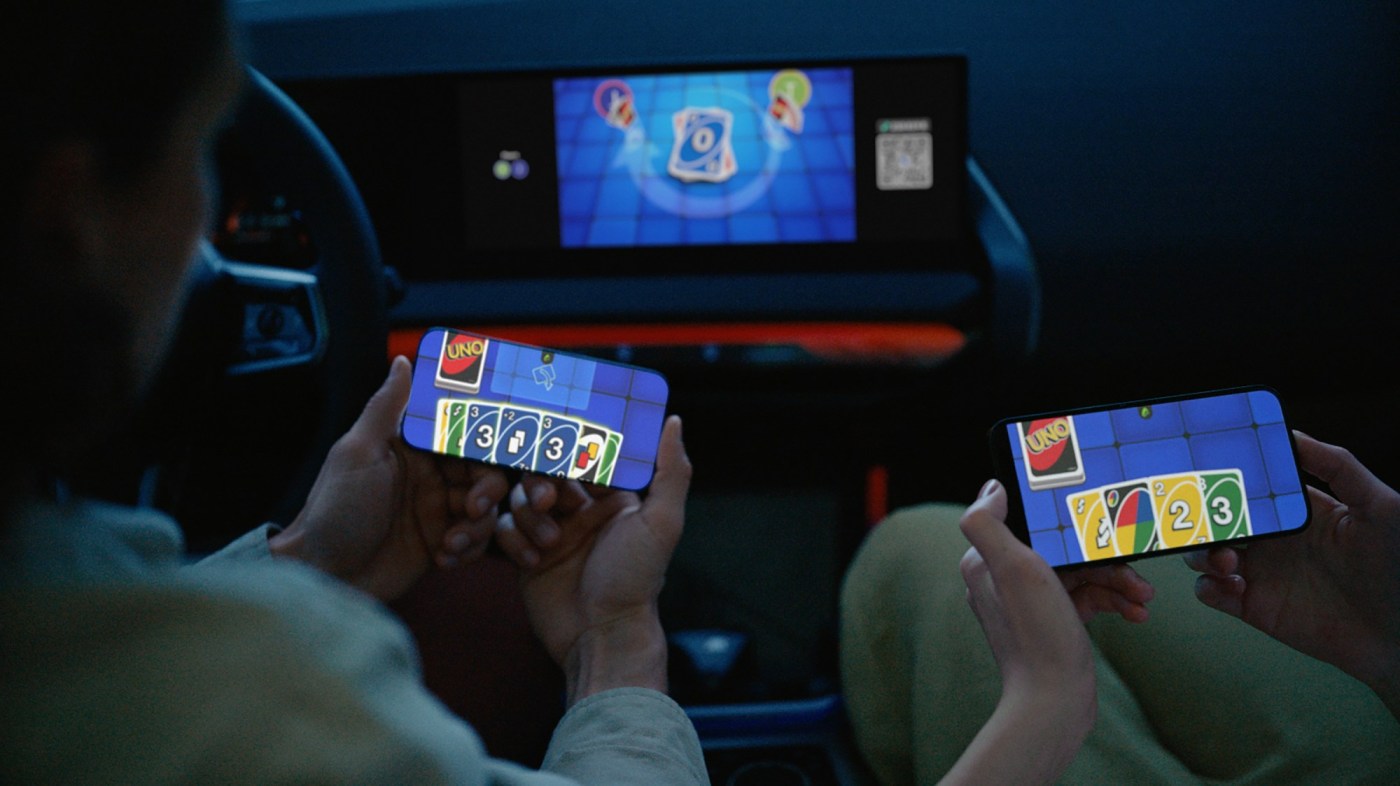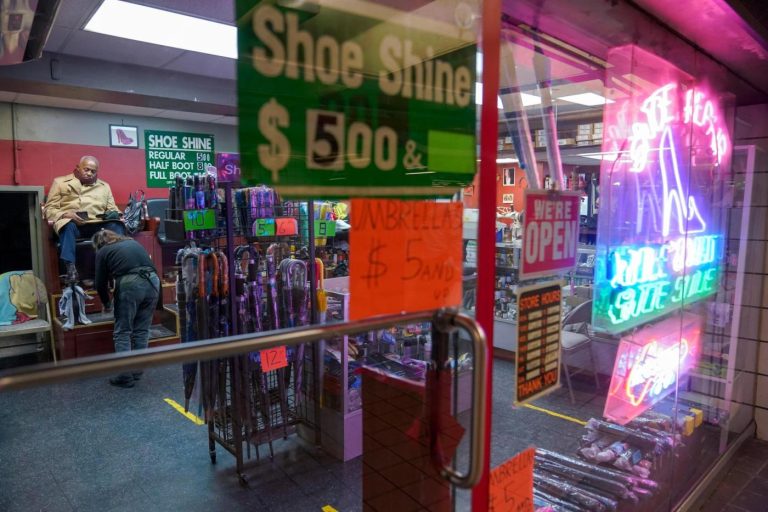Breana Noble | The Detroit News (TNS)
TROY, Michigan — The automotive industry is flipping on its head a long tradition of car racing video games by bringing the gaming experience into the vehicles.
Collect virtual coins with an augmented-reality car projected onto the live camera feed from the vehicle, play Uno through the infotainment screen or connect a Bluetooth controller and race to victory online.
Major automakers are pursuing the software-defined vehicle. With that comes more powerful computers in the vehicle and better graphic processing units. They’re looking for opportunities for recurring revenue streams in the form of subscriptions. Electric vehicles potentially create new circumstances in which customers are sitting in their vehicles for longer periods of time while charging. And every brand is seeking ways to help differentiate itself in the market and lure buyers.
Some are starting to bet that gaming could be a part of how they address those opportunities. The $183.9 billion global games market in 2023, according to gaming data platform Newzoo, could be a lucrative place to look.
“When you have an electric vehicle, the brand characteristics and brand differentiation you get from the feel and the sound, my understanding is that a lot of that is all vanishing,” said Karl Brauer, executive analyst at auto information website iSeeCars.com. “The gaming is almost like the new cool. It’s not the exhaust or how fast it goes zero to 60 (mph). It’s how big is the screen and how many cool things can you do with it? Gaming is one of them.”
Seeking relevancy
Since 2019, Tesla Inc. has offered an arcade of thousands of games like Chess and Solitaire through its vehicles’ infotainment screens. Some games like “Beach Buggy Racing 2” employ the vehicle’s steering wheel and brake to play. Newer versions of the Model S and Model X can access Valve Corp.’s Steam, an online store with thousands of games like “The Witcher 3” and “Cyberpunk 2077.”
In-vehicle gaming did come under scrutiny by the National Highway Safety and Traffic Administration in 2021 when it investigated Tesla’s Passenger Play offering that allowed vehicle passengers to play games while the vehicle was in motion. In December 2021, the EV maker agreed to remove the feature, allowing the games only to be played while the vehicle was in park.
More offerings from other brands are becoming available for when vehicles are in park. In November, BMW AG made available the AirConsole platform in its infotainment system. It features 20 games, most recently adding Mattel Inc.’s Uno and “Who Wants to be a Millionaire?” Volkswagen AG last month announced a partnership with AirConsole, as well.
“We believe that digital content is a must-have in a premium vehicle out of which gaming is one portion,” said Henning Schlieker, BMW U.S. digital products and operations manager. “More and more, we leverage the fact that we have these capabilities in the vehicle: We have the computing power in the vehicle. We have the connectivity in the vehicle. So, it’s a natural next step for us to say, ‘OK, what do we think could potentially be relevant to our customers globally?’”
Potentially increasing that relevancy, Schlieker said, is EVs: “With the ongoing and growing electrification in the vehicle, we do see scenarios more than in the past where people will be waiting maybe in public charging stations. Yes, given that the ramp-up of public charging — and maybe also the ramp-up of electrification, etc., etc. — is an ongoing process, it might take a while, but we just wanted to make clear that we prepared for this such a scenario.”
Related Articles
Tesla issues fifth Cybertruck recall in first a year of launch
AI can only do 5% of jobs, says MIT economist who fears crash
Lilly weight-loss drug copycats dealt blow as shortage ends
Map: Where the new round of tiny homes will be built in San Jose
Big Fremont office park occupied by German tech titan lands buyer
BMW buyers get a free trial for three months to a year, depending on the vehicle. Beyond that, AirConsole is a part of the Digital Premium subscription that includes BMW Maps navigation, ConnectedDrive Store for access to various apps, video streaming and individualization opportunities through the Intelligent Personal Assistant. The subscription starts at $9.99 per month, according to BMW’s website. There also is an annual option. Schlieker declined to specify what subscription adoption has looked like.
“We’re just in this phase to discover how people react to this one,” he said.
This particular partnership offers a platform that’s flexible and can adapt over time, Schlieker said. AirConsole emphasizes short social games, said Michael Fuller, vice president of games. Participants use their smartphone or other device as a controller. The game happens on the touchscreen, but players make moves on their mobile devices online or through an app.
This addresses some of the challenges with just gaming through the touchscreen, Fuller said, since that can limit gameplay to the front seat and challenges people who may sit in the driver’s seat but are left-handed. He also contrasted AirConsole’s platform with streamed platforms that have games emphasizing performance and speed — attributes to which a vehicle touchscreen usually isn’t most conducive in comparison to a laptop or gaming console.
AirConsole’s games run casual to midcore, Fuller said. Users can play individually, though most allow for four players or more.
“Especially with the mobile phones, it’s like people have just more and more been playing by themselves,” Fuller said. The AirConsole platform “brings back that board game experience almost when you’re sitting around the table and everybody’s playing, and you’re conversing and having fun together.”
AirConsole also wants to create an experience, Fuller said. In Uno, for example, interior ambient lighting changes to the color of the card a person plays in the game. Fuller said the company is looking at ways to leverage vehicle suspension, actuators in seats and sounds to enhance other gameplay, as well. The platform also wants to allow occupants of multiple vehicles to play together.
Intel Corp. last month introduced Arc Graphics for Automotive with a discrete graphics processing unit capable of offering console-quality visuals beyond mobile-like experiences. Connectivity, 5G and architectures that minimize battery drain and heat generation are making these kinds of offerings possible.
In China, Mercedes-Benz Group AG recently launched, through an over-the-air update, “Need for Speed: Assemble” in collaboration with Chinese tech conglomerate Tencent Holdings Ltd. and California-based video game company Electronic Arts Inc. The game is compatible with Bluetooth controllers. Rollout to other regions is in the works, along with other offerings.
Mercedes last month also announced a partnership with cloud gaming provider Boosteroid that has access to more than 1,000 games, including “Fortnite” and “Sea of Thieves.” The app next year will be available to be downloaded with the third-generation MBUX infotainment system’s Entertainment Package Plus in Europe and North and South America.
Ford Motor Co.’s new digital experience debuted on the 2024 Lincoln Nautilus’ panoramic display. Users have access to Google Play apps. Additionally, the Dearborn automaker worked with French video game company Gameloft SE to tailor its “Asphalt Nitro 2” racing game to the in-vehicle infotainment, or IVI, experience. Ford drivers also have immediate access to the Shelby GT350R in the game. Users can play with a Bluetooth gaming controller.
“We think it’s still very early in the development of gaming apps for the in-vehicle experience,” Ford spokesperson Alan Hall said in an email, “but we are excited to have infotainment systems that have the computing capability, beautiful displays, and user experience to enable us to enhance what our customers can do.”
Ford emphasized the power of partnerships like with Gameloft in adapting gaming for vehicle cockpits.
“The hardware capabilities of IVI systems are advancing rapidly, enabling them to handle increasingly complex software, including games — now in higher demand as families and friends spend more time together in vehicles,” Henry Pan, vice president of global business development, wrote in an email. “This makes cars an ideal setting for interactive, engaging entertainment that everyone can enjoy.
“For now, the focus should be on introducing users to in-car gaming, allowing them to enjoy this new feature. Over time, they’ll come to see the value in paying for premium content that further enhances their experience.”
Pan emphasized that easy access to in-vehicle gaming in the vehicle interface is important for its growth. In the future, he said, artificial intelligence in infotainment could suggest quick gaming opportunities when users have free time.
Prior to the Ford Digital Experience, more nascent gaming opportunities have been available on vehicles like the Mustang Mach-E. Owners of that electric SUV and other vehicles like the Jeep Grand Cherokee 4xe told The Detroit News that offerings on those vehicles were fun to show off to children and friends at first, but they could be slow to load and were comparable to basic smartphone games.
When Anne Thimm heard about the ability to play games in her Mach-E, she thought the offering sounded neat. The 63-year-old Shallotte, North Carolina, resident plays some quiz games on her phone. In practice, though, she’s never found the urge to take advantage of in-vehicle gaming in her electric Mustang. She has a Level 2 charger installed at her home to fuel up her vehicle.
“In the reality of ownership, I’ve realized, ‘Oh, why would I want to sit in my car when I can come inside my home?’” she said. “If I’m on a long trip, I go inside, use the restroom and get a soda. By then, I’m charged. I don’t sit in my car for long periods of time.”
Automakers are seeking to change that. Ford executives have spoken about leveraging technology to make their vehicles a third living space outside the home or workplace where people want to spend time.
When asked about in-vehicle gaming, Jeep and Dodge parent Stellantis NV pointed to the 2024 Dodge Charger Daytona EV. In a statement, Dodge CEO Matt McAlear said the inspiration for “real world ‘gaming’” concerning the vehicle resulted in the development of the Drive eXperience Recorder system. It allows for drag and circuit race recording, providing in-car synchronized logging of audio, video and vehicle data that drivers can analyze after their run.
General Motors Co. spokesperson Stuart Fowle said in-vehicle gaming is on the company’s radar, especially for Cadillac with pillar-to-pillar screens in the vehicle. At this time, however, it hasn’t announced any partnerships or concrete initiatives in this space.
Virtual reality
Applications of in-vehicle gaming remain in the early stages, but opportunities in mixed and virtual reality are already being explored. As the industry looks eventually toward fully autonomous driving, opportunities can open further.
“If it’s in autonomous mode or at least for kids in the back seat, and the technology can recognize where it is and where it’s heading, and you start having … it insert things into that reality, that could end up being huge,” Brauer said. “The car becomes a better environment for it.”
Performance-focused BMW M offers for $212 (190 euro) a 90-minute mixed-reality experience at its driving academy in Maisach, Germany. Participants wear virtual-reality goggles as they drive a BMW M4 Competition or BMW M2 Coupé around a track, immersed in a world that combines reality with a virtual city circuit.
Others are exploring opportunities in mixed reality for passengers. French automotive supplier Valeo SE this spring at South by Southwest in Texas introduced Racer, an extended reality in-car gaming experience for passengers developed using game engine Unity.
In the second row of the Racer vehicle, tablets feature an app into which users type their initials. The game, however, could be accessed by any type of device like a smartphone. The game augments a virtual racer onto live footage captured from the cameras already on the vehicle, and using a controller, players seek to collect the most virtual coins that appear on the road. Lightning bolts offer additional boosts to go faster, and tires and traffic cones can cause a loss of points. If the racer hits or gets in the way of a real vehicle on the road, it even spins out.
Players can customize their vehicles and characters. They also can access previously recorded feeds from other locations on which to play like the Golden Gate Bridge in San Francisco. There’s an option to turn that into a space-themed virtual experience, as well, where the vehicles on the road appear as UFOs.
Valeo has an interested customer in the product, said Derek de Bono, software-defined vehicle product vice president and group product marketing vice president. It has a proof of concept running in the second half of this year and expects to start production in 2025 or ’26.
The goal of the project, however, has been to highlight how the data that already is available using cameras and sensors on vehicles today can be used, said Jeff Shay, president of North America. The supplier also wants to see common standards for software to access that data.
“The Valeo Racer is really an exposé of how we can use existing hardware and software in the vehicle to do new things,” Shay said. “It was designed to get people dreaming about what data is available in a vehicle, and how we can take that data and the data coming from this hardware, to do things we’ve never thought of before and create new markets that we’ve never thought of before.”
©2024 www.detroitnews.com. Visit at detroitnews.com. Distributed by Tribune Content Agency, LLC.












